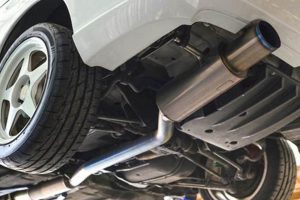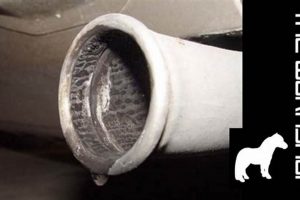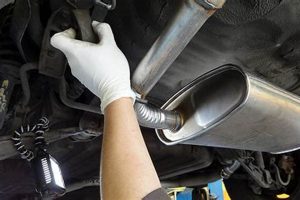Operating a vehicle without a fully functional exhaust silencing component, commonly referred to as a muffler, is a practice that involves the removal or significant degradation of a device designed to reduce engine noise. For instance, a vehicle with a detached or heavily corroded muffler will produce a considerably louder sound output than a vehicle with a properly functioning system.
The potential consequences of doing so are multifaceted. Many jurisdictions have noise ordinances that establish maximum permissible sound levels for vehicles. Violating these ordinances can result in fines and penalties. Furthermore, the increased noise pollution can negatively impact the quality of life in residential areas and contribute to general environmental disturbance. Historically, regulations concerning vehicle noise have been implemented to promote public health and maintain peaceful community environments.
The legal aspects, potential performance changes, and practical implications of running a vehicle in such a condition merit detailed examination. Factors like local regulations, potential engine damage, and the overall driving experience should all be carefully considered. The following sections will explore these aspects in greater depth, providing a comprehensive understanding of this topic.
Guidance Regarding Operation of a Vehicle Without a Muffler
The subsequent guidelines address considerations relevant to the operation of a vehicle lacking a functional muffler. These points are intended to provide a comprehensive understanding of potential ramifications.
Tip 1: Assess Local Regulations: Prior to operating a vehicle without a muffler, diligently examine all applicable noise ordinances and vehicle codes within the relevant jurisdiction. Many areas have strict regulations regarding vehicle noise levels, and non-compliance may result in significant fines or other penalties.
Tip 2: Evaluate Potential Performance Impact: While some argue that removing a muffler may marginally increase engine horsepower, this effect is often negligible and can potentially negatively affect engine backpressure, especially in vehicles not specifically designed for such modifications. A professional evaluation is recommended before undertaking such alterations.
Tip 3: Consider the Environmental Impact: Vehicles operating without mufflers generate significantly more noise pollution. This increased noise level can disrupt residential areas and contribute to an overall decline in environmental quality. Responsible vehicle operation necessitates considering the impact on the surrounding community.
Tip 4: Acknowledge Potential Safety Concerns: The heightened noise levels associated with operating a vehicle sans muffler can make it more difficult to hear emergency vehicle sirens or other crucial auditory cues, potentially increasing the risk of accidents.
Tip 5: Anticipate Increased Attention from Law Enforcement: Vehicles that are noticeably louder than legally permissible are more likely to attract the attention of law enforcement officials. Frequent stops and inspections may result, particularly in areas with strict noise control measures.
Tip 6: Evaluate Exhaust System Integrity: If contemplating muffler removal, assess the overall condition of the remaining exhaust system. A weakened or corroded system may be further compromised without the structural support provided by a muffler, potentially leading to leaks or system failure.
Tip 7: Understand Resale Value Implications: Modifying a vehicle’s exhaust system, especially by removing components, can negatively impact its resale value. Potential buyers may be wary of vehicles with altered exhaust systems due to concerns about legality, maintenance, and reliability.
These guidelines emphasize the critical need to carefully weigh the potential legal, performance, environmental, safety, and financial implications before operating a vehicle that lacks a functioning muffler. A responsible approach prioritizes adherence to regulations and consideration for the well-being of the community.
The subsequent discussion will explore further aspects relevant to responsible vehicle operation and maintenance.
1. Legality
The legality of operating a vehicle without a functioning muffler is a central consideration when addressing the question of whether it is permissible to drive a vehicle in such a condition. This aspect is governed by a complex interplay of federal, state, and local regulations, each defining acceptable noise levels and vehicle equipment standards. Compliance with these regulations is not only a legal imperative but also a matter of responsible vehicle operation.
- Federal Noise Standards
While federal regulations primarily target vehicle manufacturers, setting standards for newly produced vehicles, these regulations indirectly influence state and local laws. These federal standards establish a baseline for acceptable noise levels, which states often adopt or build upon in their own vehicle codes. Non-compliance at the manufacturing level can lead to recalls and penalties.
- State Vehicle Codes
Individual states enact their own vehicle codes, often incorporating and expanding upon federal guidelines. These codes typically include specific provisions regarding exhaust systems and noise emissions. These provisions often specify that vehicles must be equipped with mufflers in good working order to prevent excessive or unusual noise. Violation of these state vehicle codes can result in fines, citations, and even vehicle impoundment.
- Local Noise Ordinances
At the local level, cities and counties may implement noise ordinances that further restrict permissible noise levels. These ordinances are often stricter than state laws and may specifically target vehicle noise in residential areas. These ordinances can prescribe maximum decibel levels at certain distances and times of day, and operating a vehicle without a muffler frequently violates these local standards.
- Enforcement and Penalties
Enforcement of vehicle noise regulations varies by jurisdiction. Law enforcement officers may issue citations based on visual inspection, auditory assessment, or the use of decibel meters. Penalties for violating these regulations can range from monetary fines to mandatory vehicle repairs and re-inspection. Repeat offenders may face more severe consequences, including license suspension.
In summary, the legality of driving a vehicle lacking a muffler is unequivocally contingent upon adherence to the applicable federal, state, and local regulations. The consequences of non-compliance can be significant, underscoring the importance of maintaining a functioning exhaust system that meets established noise emission standards.
2. Increased Noise
The amplified sound output directly relates to the operation of a vehicle without a muffler. This fundamental change in the vehicle’s acoustic signature has cascading effects, impacting legal compliance, environmental quality, and the overall driving experience.
- Decibel Levels and Regulations
The removal or absence of a muffler significantly increases the decibel level of a vehicle’s exhaust. This increase often exceeds the permissible limits set by local, state, and federal noise regulations. For example, a vehicle with a functioning muffler might register 75 decibels, whereas the same vehicle without a muffler could easily exceed 90 decibels. This violation of decibel limits can result in fines and legal penalties.
- Community Impact
Vehicles operating without mufflers contribute substantially to noise pollution within communities. The amplified engine noise can disrupt residential areas, impacting sleep patterns, concentration, and overall quality of life. Instances of community complaints and increased enforcement actions are common in areas where unmuffled vehicles are prevalent. The intrusive noise negatively affects public spaces and diminishes the acoustic environment.
- Acoustic Signature and Identification
The distinct acoustic signature produced by a vehicle lacking a muffler makes it easily identifiable, even at a distance. This increased audibility makes the vehicle more likely to attract attention from law enforcement. The unusual sound profile serves as a clear indicator of a potential violation, prompting further investigation by authorities. The characteristic rumble and roar of an unmuffled engine are readily recognizable.
- Driver and Passenger Discomfort
The amplified noise within the vehicle itself can lead to increased driver and passenger discomfort. Prolonged exposure to high decibel levels can cause fatigue, stress, and even hearing damage. The incessant roar of the engine makes conversation difficult and detracts from the overall driving experience. The internal acoustic environment becomes significantly less conducive to a comfortable and safe journey.
The connection between increased noise and operating a vehicle absent of its muffler is clear. The elevated decibel levels, community disturbances, distinct acoustic signature, and potential discomfort underscore the significance of maintaining a functional muffler to comply with regulations and promote a more peaceful environment. The repercussions extend beyond mere inconvenience, impacting public health and legal standing.
3. Performance
The effect on vehicular performance when operating without a muffler, though frequently discussed, often presents a complex and nuanced reality. The absence of a muffler changes exhaust flow dynamics, which can influence engine power output and efficiency. Some proponents suggest that removing the muffler reduces backpressure, theoretically allowing the engine to expel exhaust gases more easily, potentially leading to increased horsepower. However, this assertion is not universally valid and depends heavily on engine design and exhaust system characteristics. In many modern vehicles, the exhaust system is carefully engineered to optimize backpressure for specific engine operating conditions. Altering this balance can, in some cases, reduce overall performance, particularly at lower engine speeds.
The practical implications of these performance changes are multifaceted. On one hand, some drivers might perceive a slight increase in acceleration at higher speeds, leading them to believe that the removal of the muffler has enhanced performance. Conversely, the loss of backpressure can result in reduced torque at lower RPMs, making the vehicle feel sluggish during everyday driving scenarios. Moreover, the altered exhaust flow can affect fuel efficiency, either positively or negatively, depending on the engine management system’s ability to adapt to the changed conditions. Real-world examples include cases where modified vehicles exhibit increased horsepower on a dynamometer but suffer from decreased fuel economy and drivability in normal traffic.
In conclusion, while the concept of increased performance through muffler removal exists, its realization is far from guaranteed and often comes with trade-offs. The notion that it improves performance is highly dependent on the vehicle’s specific engine design, the expertise of any modifications, and driving conditions. Furthermore, any potential performance gains must be weighed against the legal, environmental, and safety considerations associated with operating a vehicle without a functioning muffler, the degradation that can follow from back pressure changes or the reduction of, and the potential need for further optimization of components due to changes made in the performance of a vehicle.
4. Safety
The operation of a motor vehicle without a muffler introduces several safety considerations that warrant careful evaluation. The absence of this component can impact both the driver’s awareness and the vehicle’s overall operational safety, potentially increasing the risk of accidents.
- Reduced Auditory Awareness
The increased noise levels resulting from operating without a muffler can significantly impede a driver’s ability to hear critical auditory cues. Emergency vehicle sirens, horns from other vehicles, and even the sounds of pedestrians or cyclists become more difficult to detect against the backdrop of the amplified engine noise. This diminished auditory awareness can delay a driver’s reaction time in hazardous situations, increasing the likelihood of collisions. An example includes a driver failing to hear an approaching ambulance siren due to the overwhelming engine noise, leading to a near-miss incident at an intersection.
- Increased Driver Fatigue and Stress
Prolonged exposure to elevated noise levels, as experienced when driving without a muffler, can contribute to driver fatigue and stress. The constant drone of the engine and exhaust can be mentally taxing, reducing a driver’s focus and concentration. Fatigue and stress can impair judgment, slow reaction times, and increase the risk of errors behind the wheel. A commercial driver operating a truck without a muffler on a long haul might experience heightened fatigue, leading to decreased vigilance and an increased risk of accidents.
- Potential Exhaust System Hazards
While not directly related to the absence of the muffler itself, operating a vehicle with a compromised exhaust system, which often accompanies muffler removal, can create potential safety hazards. Leaks in the exhaust system can allow dangerous gases, such as carbon monoxide, to enter the vehicle’s cabin. Carbon monoxide is odorless and colorless, making it difficult to detect, and exposure can lead to serious health problems, including unconsciousness and even death. Furthermore, damaged exhaust components can pose a fire risk if they come into contact with flammable materials.
- Distraction and Aggressive Driving
The amplified noise produced by a vehicle without a muffler can be distracting to both the driver and other motorists. This distraction can lead to aggressive driving behaviors, such as speeding and reckless lane changes, as drivers attempt to compensate for the perceived lack of power or simply react to the irritating noise. Aggressive driving significantly increases the risk of accidents and endangers all road users.
These safety considerations underscore the importance of maintaining a functional muffler. The amplified noise can compromise auditory awareness, heighten driver fatigue and stress, and create potential hazards related to exhaust leaks and aggressive driving. This presents clear safety implications, emphasizing the necessity of a fully operational vehicle exhaust system.
5. Vehicle Condition
The practice of operating a vehicle without a muffler significantly interrelates with the overall condition of the automobile. The absence of a muffler not only impacts noise levels but also exerts influence on the exhaust system’s integrity and potentially, the engine’s functionality. Pre-existing conditions, such as rust or weakened exhaust hangers, can be exacerbated by the removal or degradation of this component. A muffler provides structural support, and its absence may lead to increased stress on other exhaust components, accelerating their deterioration. An example can be observed in older vehicles where the muffler’s removal resulted in the premature failure of the catalytic converter due to increased vibration and stress on the adjoining pipes. Understanding this interaction is critical for assessing the long-term consequences of operating a vehicle in such a condition.
Furthermore, the engine’s condition plays a crucial role in how the vehicle responds to the absence of a muffler. In engines with pre-existing issues, such as poor valve seals or worn piston rings, the altered backpressure dynamics can exacerbate these problems. The loss of backpressure might allow for increased oil consumption or lead to erratic engine performance. Modern vehicles with sophisticated engine management systems may compensate for some of these changes, but older or less advanced vehicles are more susceptible to negative impacts. The condition of the catalytic converter, oxygen sensors, and other emission control devices also influences the overall outcome. A clogged catalytic converter, for instance, can create excessive backpressure regardless of the presence or absence of a muffler, masking any potential performance changes.
In conclusion, the practice of operating a vehicle without a muffler is inextricably linked to the vehicle’s overall condition. Pre-existing weaknesses in the exhaust system can be amplified, and engine health can significantly impact how the vehicle responds to the altered exhaust dynamics. Recognizing this connection is essential for making informed decisions about vehicle maintenance and operation, minimizing potential damage, and adhering to legal and environmental standards. The interplay of component conditions and engine health is fundamental to understanding the implications of not utilizing a muffler.
Frequently Asked Questions
The following section addresses common inquiries regarding the operation of a vehicle lacking a muffler. The information provided aims to clarify potential ramifications and provide informative responses.
Question 1: Is operation of a vehicle without a muffler permissible under any circumstances?
Operation is generally impermissible on public roads due to noise regulations. Exceptions may exist for off-road or private property use, but local ordinances must be consulted.
Question 2: What are the potential legal consequences of driving without a muffler?
Legal repercussions can include fines, citations, mandatory vehicle inspections, and, in some jurisdictions, vehicle impoundment. Repeat offenses may lead to more severe penalties.
Question 3: Can removal of a muffler improve a vehicle’s performance?
While some hypothesize a marginal increase in horsepower, the effect is often negligible and may negatively impact engine backpressure, reducing low-end torque and fuel efficiency. Professional evaluation is advised.
Question 4: How does operating without a muffler impact the environment?
The absence of a muffler results in increased noise pollution, disrupting residential areas and negatively impacting environmental quality. This elevated noise level contributes to community disturbances.
Question 5: Does driving without a muffler pose any safety risks?
Elevated noise levels can impair a driver’s ability to hear emergency vehicle sirens and other critical auditory cues, increasing the risk of accidents. Driver fatigue can also be exacerbated.
Question 6: Will removing a muffler affect a vehicle’s resale value?
Modifying or removing exhaust system components, including the muffler, can negatively impact resale value. Potential buyers may be wary of vehicles with altered exhaust systems.
The responses above highlight the legal, environmental, performance, and safety implications associated with operating a vehicle without a muffler. Adherence to regulations and consideration for the community are paramount.
The next section will delve into best practices for maintaining a vehicle’s exhaust system to ensure compliance and optimal performance.
Conclusion
The preceding exploration of “can you drive car without muffler” reveals a complex intersection of legal, environmental, performance, and safety considerations. The widespread prohibition against such practice arises from a confluence of factors, notably noise pollution concerns, adherence to established vehicle codes, and the potential for compromised driver awareness and increased accident risk. The marginal performance gains, often touted by proponents, are frequently outweighed by the tangible negative consequences and potential legal ramifications.
The operation of vehicles should always prioritize compliance with applicable regulations and the safety of all road users. The deliberate circumvention of established vehicle equipment standards carries inherent risks and demonstrates a disregard for community well-being. Responsible vehicle ownership necessitates a commitment to maintaining all safety and emissions equipment in proper working order. Therefore, individuals should seek qualified professional guidance when addressing exhaust system concerns and strive to uphold both the letter and the spirit of the law.







